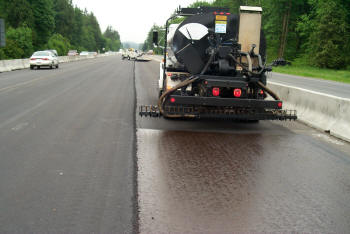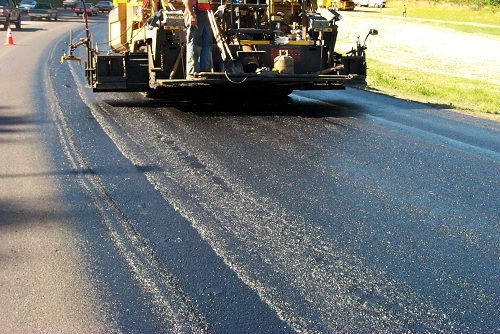In the last RoadReady newsletter, we talked about factors to consider when using milling as a surface preparation. In this newsletter issue, we wanted to look at another existing surface preparation – the application of a tack coat or emulsifier.Do either of the pictures below look familiar? Tack coats are an important step in constructing a quality pavement, that when applied properly, will establish a bond with the existing surface and help prevent pavement distresses like potholes and cracking. When applied poorly, pavement life will decrease and life cycle costs will increase.
The picture below illustrates good tack coat application (left) vs. a poor tack job (right).
 |
 |
Many factors contribute to successful and effective tack coat application. In this RoadReady newsletter, we are going to focus specifically on what to monitor and check on the tack truck during application.
Tack Truck Considerations
Tack trucks (or asphalt distributors) have several components that need to be maintained and checked prior to laying down a quality tack coat: nozzle spray pattern consistency, the spray bar height, pressure in the spray bar and tack coat temperature.
Nozzle Spray Patterns
Nozzles along the spray bar need to lay down tack coats in consistent patterns to ensure consistent surface coverage. Below are images illustrating incorrect as well as correct spray patterns.This first image shows inconsistent spray patterns. The tack coat has uneven gaps and won’t be as effective in bonding the two layers of pavement together. The asphalt mix placed over this tack coat will be subject to distresses sooner than a road paved after a quality tack coat.

Note: This image also illustrates the application of too little tack coat most likely due to the spray bar height being too low (see the next section as well for more information on spray bar height)

Spray Bar Height
The spray bar of the tack truck needs to be high enough above the roadway so that tack from the nozzles reaches the entire surface, with no gaps in coverage. Depending on intended application rate, the height may need to be set for double or triple coverage. (Note: the application rate, normally measured in gallons per square yard, corresponds to the amount of tack applied to the surface and is often determined by project specifications). If the spray bar is too low, streaks are present. If it is too high, there will be gaps in coverage. When starting a tack coat, this should be checked and calibrated if necessary.
To maintain a consistent application rate, the height of the spray bar also needs to remain constant. As the emulsion is sprayed from the tank, the truck gets lighter and the spray bar could rise up enough to impact the tack coat coverage. The tack truck should compensate for this automatically, but it needs to be monitored during application.
Pressure and Nozzles
A constant pressure in the spray bar will help provide a consistent application of the emulsion. When you have inconsistent pressure, you get inconsistent application. One key element to maintaining appropriate pressure and ensuring even spray patterns, is making sure the nozzles on the spray bar are free from clogs. Clogged nozzles, as illustrated in the image below, will leave uneven spray patterns and can also cause inconsistent pressure levels in the spray bar.

The next image illustrates good pressure, as well as appropriate spray bar height and good nozzle spray patterns.
Temperature
Temperature of the emulsion needs to be within the appropriate range, typically between 70 F and 165 F depending on type and grade of the emulsion. When an emulsion is too hot, it “breaks” (water in the emulsion evaporates) which makes it virtually impossible to apply effectively. Many tack trucks are heated to prevent cooling during transport, but monitoring the temperature of the emulsion is essential to the proper application of a tack coat.
Pulling It All Together
By properly controlling spray patterns, spray bar height, pressure, and temperature, you’ll be able to do perform quality tack jobs, leading to durable bonding between pavement layers. This ultimately will lead to increased pavement quality and longer service life attributed to good construction practices.



Terrific website – I love Pavement Interactive.
Question – on this page:
http://paveinteract2.wpengine.com/2010/06/30/tack-coats-application-considerations/
Do you have the description of what is a good and poor (left and right) tack coat on the photo reversed?
Mike
It looks like that was a formatting issue – on my screen, the photos were showing up as top and bottom, not left and right. This should be fixed now.